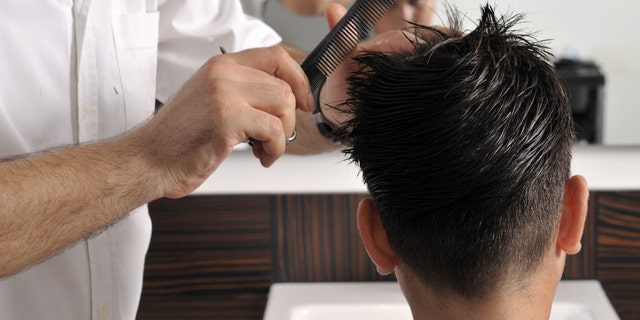Kids with head lice don’t need to leave school: report

health Eshrag:
NEWYou can now listen to Fox News articles!
Health experts at the American Academy of Pediatrics (AAP) say children don’t have to be sent home from school if they have head lice.
The Illinois-based association of pediatricians issued a clinical report on Monday, Sept. 26, which states lice are not a “health hazard” because they are not connected to disease and have a low transmission rate.
“There is significant stigma resulting from head lice infestations in high-income countries, resulting in children and adolescents being ostracized from their schools, friends, and other social events,” the AAP’s report said. “Head lice can be psychologically stressful to the affected individual.”
FDA WARNS AGAINST USING HEAD LICE DRUG IVERMECTIN TO TREAT CORONAVIRUS
The AAP recommends against “no-nit” policies that prohibit students from attending school while having a lice infestation.
The association warned that such policies haven’t been proven to be effective and could put a school at legal risk because it may violate the civil liberties of students.
Caregivers and medical professionals should instead focus on providing lice education and treatment, according to the AAP.
Treatment options include pediculicides – lice killing agents – approved by the U.S. Food and Drug Administration, including permethrin 1% lotion, pyrethrin and piperonyl butoxide shampoo, ivermectin 0.5% lotion or an ivermectin 3-milligram tablet, malathion 0.5% lotion and spinosad 0.9% suspension.
FLORIDA TEEN REPORTEDLY CONTRACTS ‘BRAIN-EATING AMOEBA’ AFTER SWIMMING
Alternative treatments the AAP recommends include using botanical agents for killing or repelling lice, occlusive agents, desiccants and manual removal.
A child is treated for lice in this stock image.
(iStock)
– Botanical agents for killing or repelling lice: Various essential oils, such as Ageratum, Aloysia, Aniba, Annona, Cananga [ylang ylang], Cinnamomum, Cocos, Curcuma, Elletaria, Eucalyptus, Eugenia, Geranium, Heliantus, Juniperus, Lavandula, Lippia, Litsea, Melaleuca, Melia, Mentha, Monarda, Myrcianthes, Origanum, Pimpinella, Rosmarinus, Salvia, Schinus, Tagetes, tea tree, Zingiberaceae or citronella
– Occlusive agents: Home remedies made with petrolatum, mayonnaise, melted butter or margarine, olive oil, dimethicone or face cleanser
– Desiccants: Natrum muriaticum, isopropyl myristate or an AirAllé device
– Manual removal: Physical and electronic nit combs, vinegar-based products or hair shaving
OYSTER FOOD SAFETY TIPS YOU SHOULD KNOW FOLLOWING 2 REPORTED DEATHS LINKED TO THE SHELLFISH
Caregivers and school personnel who are without health care backgrounds should contact medical professionals if single or community-wide lice infestations show resistance toward over-the-counter treatments, the AAP’s report said.
The AAP also noted that lice cannot hop or jump and can only travel by crawling – meaning transmission usually occurs between people who have direct contact with lice-infested hair.

A barber cuts a child’s hair with scissor at a barbershop.
(iStock)
Head-to-head contact is the most common transmission method, but indirect spread can happen through when someone makes contact with personal belongings that are shared with a lice-infested person, such as combs, brushes, hats and sports helmets.
These indirect transmission methods are “much less likely to occur,” according to the AAP.
CLICK HERE TO GET THE FOX NEWS APP
“Lice found on combs are likely to be injured or dead, and a louse is not likely to leave a healthy head unless there is a heavy infestation,” the AAP wrote in its updated report.
“In one study, live lice were found on only 4% of pillowcases used by infested persons,” the AAP continued. “Thus, the major focus of control activities should be to reduce the number of lice on an individual’s head and to lessen the risks of head-to-head contact.”

Lice are wingless parasitic insects that can be found on human heads, eyebrows, eyelashes and other hair-covered body parts.
(iStock)
The U.S. Centers for Disease Control and Prevention (CDC) agrees with the AAP’s stance on head lice in schools.
The national health agency acknowledges that lice can be a “nuisance” on its “Head Lice Information for Schools” webpage, but the CDC goes on to say that these parasitic insects haven’t been shown to spread disease and aren’t an indicator of poor personal hygiene or cleanliness.
FOLLOW US ON FACEBOOK FOR MORE FOX LIFESTYLE NEWS
“Students diagnosed with live head lice do not need to be sent home early from school; they can go home at the end of the day, be treated, and return to class after appropriate treatment has begun,” the CDC wrote. “Nits may persist after treatment, but successful treatment should kill crawling lice.”
Noting that the news was copied from another site and all rights reserved to the original source.
xnxx,
xvideos,
porn,
porn,
xnxx,
Phim sex,
mp3 download,
sex 4K,
Straka Pga,
gay teen porn,
Hentai haven,
free Hentai,
xnxx,
xvideos,
porn,
porn,
xnxx,
Phim sex,
mp3 download,
sex 4K,
Straka Pga,
gay teen porn,
Hentai haven,
free Hentai,


